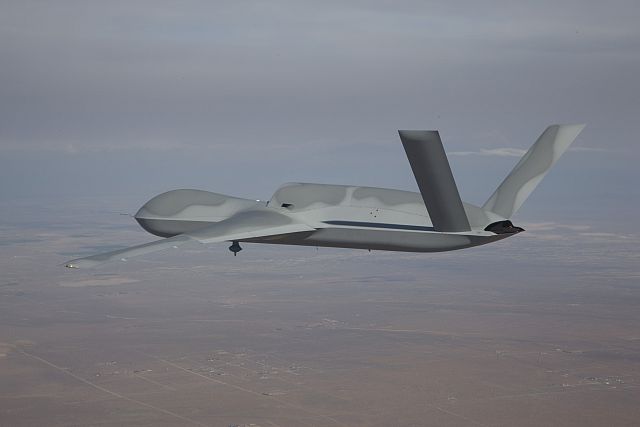The US Air Force is planning to develop a heavier, more powerful version of the jet-powered, reduced signature Predator C Avenger for deployment soon in combat zones.
“General Atomics Systems Inc. has shown the ability and willingness to quickly ramp up production capacity if the Air Force and other customers decide to rapidly field the Predator C,” states an Air Force acquisition document. Those customers are the CIA and other U.S. intelligence agencies. That means a Predator C-plus with more and larger sensors and weapons could become the next-generation stealth UAS design. That would relieve the Pentagon of having to create a new MQ-X in a budget environment that is guaranteed to quash new programmes. General Atomics is the “only company that has built and flown a demonstrator with the required capabilities [which include some stealth and heavier weapons] and is developing a larger, more capable version suitable for deployment,” the Air Force document states. The project was already under way before the loss of a reduced signature UAS near Kashmar in northeastern Iran Dec. 4, say U.S. officials.
The Air Force’s secretive Big Safari—a rapid-acquisition organization—is overseeing the Predator C project. However, USAF officials say the effort is expected to quickly expand beyond a single-aircraft demonstrator programme. They also contend that the Avenger’s radar reflectivity can be made smaller and that UAS stealth is one of the capabilities to be studied in the test programme.
General Atomics Aeronautical Systems, which builds the Predator family, has operated from a U.S. military facility at the Kandahar (Afghanistan) International Airport for at least four years. It housed Predators and the then-secret Lockheed-Martin RQ-170 Sentinel (first photographed at Kandahar) that crashed.
Among the Predator C’s initial payloads will be Goodrich’s MS-177 with a long-range, multi-spectral 177-in. focal-length sensor. It was demonstrated on the E-8C Joint Stars programme so that radar and video data could be fused. A similar system flew on the U-2, where it was paired with a signals intelligence payload to collect fused video and electronic emissions. The MS-177 is an oblique photographic sensor using dual-band imaging over three independent optical fields of view. Modes include wide-area and line search, pinpoint and stereo targeting. Another option is full-motion video like that carried by the RQ-170 to collect data on Osama bin-Laden. Signals intelligence is considered to be a likely add-on.
The $15 million sole-source procurement contract to General Atomics is to provide a test aircraft for the project. The contract was to have been awarded in November, but budget constraints intervened. According to the justification for “other than a full and open competition,” the test aircraft is needed to develop “next-generation UAS sensors, weapons and tactics, techniques and procedures” and thereby allow “quick, smooth and efficient fielding of these advanced capabilities to the area of operations.” The argument put forward by the 645th Aeronautical Group, aka Big Safari, stationed at Wright-Patterson AFB, Ohio, included a Pentagon decision that there are insufficient assets in Afghanistan to gather the necessary information, fully engage the present threat and prepare for the next generation of conflict.
Big Safari offers a streamlined acquisition process regularly used for urgent requirements. The acquisitions are critical, quick-reaction-type supplies/services deemed necessary for national security and that are outside normal acquisition parameters. Projects during the Cold War often involved equipping transport as well as high-performance aircraft with clandestine cameras and electronic surveillance devices.
The request also noted that in addition to the need outlined by USAF, the project provides a test platform for both the Secretary of Defense and intelligence agency “customers under an ongoing, classified [defense-secretary]-directed program.” The July 5 letter of direction predated the Sentinel crash. The Predator C is designed to provide a “significantly increased weapons and sensors payload capability,” and it is much faster than the MQ-9 Reaper. The aircraft has an internal weapons bay and three hard points on each wing. Funding will come from 3,600 research and development accounts.
The future seems bright for General Atomics because the memo also calls for a “permanent, next-generation UAS test capability,” which indicates additional production of the jet. The first Avenger has been flying on a weekly basis; the second aircraft produced should make its first flight soon. The aircraft slated for Afghanistan will be sequenced for later production, says an aerospace industry insider.
Source: Aviation Week

